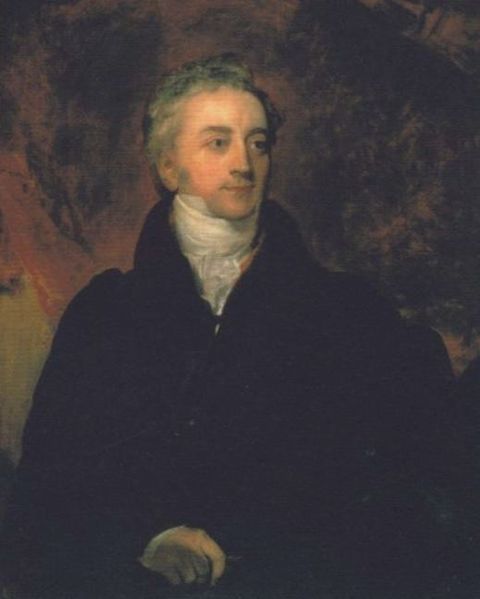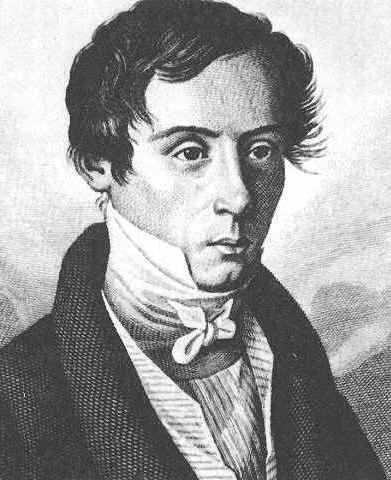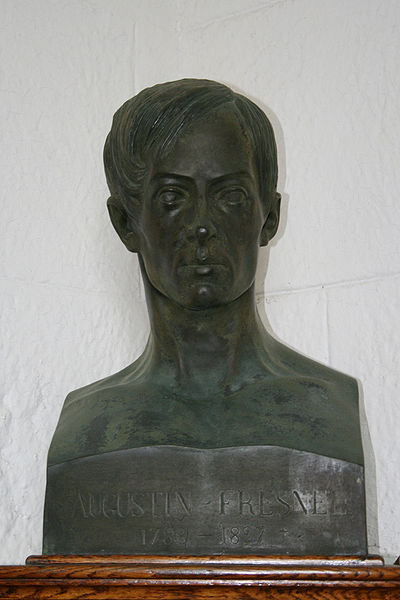<Back to Index>
- Physicist and Physiologist Thomas Young, 1773
- Physicist Augustin - Jean Fresnel, 1788
PAGE SPONSOR


Thomas Young (13 June 1773 – 10 May 1829) was an English polymath. He is famous for having partly deciphered Egyptian hieroglyphics (specifically the Rosetta Stone) before Jean - François Champollion eventually expanded on his work. He was admired by, among others, Herschel and Einstein.
Young made notable scientific contributions to the fields of vision, light, solid mechanics, energy, physiology, language, musical harmony and Egyptology.
Young belonged to a Quaker family of Milverton, Somerset, where he was born in 1773, the eldest of ten children. At the age of fourteen Young had learned Greek and Latin and was acquainted with French, Italian, Hebrew, German, Chaldean, Syriac, Samaritan, Arabic, Persian, Turkish and Amharic.
Young began to study medicine in London in 1792, moved to Edinburgh in 1794, and a year later went to Göttingen, Lower Saxony, Germany, where he obtained the degree of doctor of physics in 1796. In 1797 he entered Emmanuel College, Cambridge. In the same year he inherited the estate of his granduncle, Richard Brocklesby, which made him financially independent, and in 1799 he established himself as a physician at 48 Welbeck Street, London (now recorded with a blue plaque). Young published many of his first academic articles anonymously to protect his reputation as a physician.
In 1801 Young was appointed professor of natural philosophy (mainly physics) at the Royal Institution. In two years he delivered 91 lectures. In 1802, he was appointed foreign secretary of the Royal Society, of which he had been elected a fellow in 1794. He resigned his professorship in 1803, fearing that its duties would interfere with his medical practice. His lectures were published in 1807 in the Course of Lectures on Natural Philosophy and contain a number of anticipations of later theories.
In 1811 Young became physician to St. George's Hospital, and in 1814 he served on a committee appointed to consider the dangers involved in the general introduction of gas into London. In 1816 he was secretary of a commission charged with ascertaining the precise length of the second's or seconds pendulum (the length of a pendulum whose period is exactly 2 seconds), and in 1818 he became secretary to the Board of Longitude and superintendent of the HM Nautical Almanac Office.
A few years before his death he became interested in life insurance, and in 1827 he was chosen one of the eight foreign associates of the French Academy of Sciences. In 1828, he was elected a foreign member of the Royal Swedish Academy of Sciences.
Thomas Young died in London on 10 May 1829, and was buried in the cemetery of St. Giles Church in Farnborough, Kent, England.
Later scholars and scientists have praised Young's work although they may know him only through achievements he made in their fields. His contemporary Sir John Herschel called him a "truly original genius". Albert Einstein praised him in the 1931 foreword to an edition of Newton's Opticks. Other admirers include physicist Lord Rayleigh and Nobel laureate Philip Anderson.
Thomas Young's name has been adopted as the name of the London based Thomas Young Centre, an alliance of academic research groups engaged in the theory and simulation of materials.
In Young's own judgment, of his many achievements the most important was to establish the wave theory of light.
To do so, he had to overcome the century old view, expressed in the
venerable Isaac Newton's "Optics", that light is a particle.
Nevertheless, in the early 19th century Young put forth a number of
theoretical reasons supporting the wave theory of light, and he
developed two enduring demonstrations to support this viewpoint. With
the ripple tank he demonstrated the idea of interference in the context of water waves. With the two - slit, or double - slit experiment, he demonstrated interference in the context of light as a wave. In a paper entitled Experiments and Calculations Relative to Physical Optics, published in 1804, Young describes an experiment in which he placed a narrow card (approx. 1/30th in.) in a beam of light from
a single opening in a window and observed the fringes of color in the
shadow and to the sides of the card. He observed that placing another
card before or after the narrow strip so as to prevent light from the
beam from striking one of its edges caused the fringes to disappear. This supported the contention that light is composed of waves. Young
performed and analyzed a number of experiments, including interference
of light from reflection off nearby pairs of micrometer grooves, from
reflection off thin films of soap and oil, and from Newton's rings. He also performed two important diffraction experiments using fibers and long narrow strips. In his Course of Lectures on Natural Philosophy and the Mechanical Arts (1807) he gives Grimaldi credit
for first observing the fringes in the shadow of an object placed in a
beam of light. Within ten years, much of Young's work was reproduced and
then extended by Fresnel. (Tony Rothman in Everything's Relative and Other Fables from Science and Technology argues that there is no clear evidence that Young actually did the two - slit experiment.)
Young described the characterization of elasticity that came to be known as Young's modulus, denoted as E, in 1807, and further described it in his Course of Lectures on Natural Philosophy and the Mechanical Arts.
However, the first use of the concept of Young's modulus in experiments was by Giordano Riccati in 1782 – predating Young by 25 years.
Furthermore, the idea can be traced back to a paper by Leonhard Euler published in 1727, some 80 years before Thomas Young's 1807 paper.
The Young's modulus relates the stress (pressure) in a body to its associated strain (change in length as a ratio of the original length); that is, stress = E × strain, for a uniaxially loaded specimen. Young's modulus is independent of the component under investigation; that is, it is an inherent material property (the term modulus refers to an inherent material property). Young's Modulus allowed, for the first time, prediction of the strain in a component subject to a known stress (and vice versa). Prior to Young's contribution, engineers were required to apply Hooke's F = kx relationship to identify the deformation (x) of a body subject to a known load (F), where the constant (k) is a function of both the geometry and material under consideration. Finding k required physical testing for any new component, as the F = kx relationship is a function of both geometry and material. Young's Modulus depends only on the material, not its geometry, thus allowing a revolution in engineering strategies.
Young has also been called the founder of physiological optics. In 1793 he explained the mode in which the eye accommodates itself to vision at different distances as depending on change of the curvature of the crystalline lens; in 1801 he was the first to describe astigmatism; and in his Lectures he presented the hypothesis, afterwards developed by Hermann von Helmholtz,
that color perception depends on the presence in the retina of three
kinds of nerve fibers which respond respectively to red, green and
violet light. This foreshadowed the modern understanding of color vision, in particular the finding that the eye does indeed have three color
receptors which are sensitive to different wavelength ranges.
In 1804, Young developed the theory of capillary phenomena on the principle of surface tension. He also observed the constancy of the angle of contact of a liquid surface with a solid, and showed how from these two principles to deduce the phenomena of capillary action.
In 1805 Pierre - Simon Laplace, the French philosopher, discovered the significance of meniscus radii with respect to capillary action.
In 1830 Carl Friedrich Gauss, the German mathematician, unified the work of these two scientists to derive the Young – Laplace equation, the formula that describes the capillary pressure difference sustained across the interface between two static fluids.
Young was the first to define the term "energy" in the modern sense.
Young’s equation describes the contact angle of
a liquid drop on a plane solid surface as a function of the surface
free energy, the interfacial free energy and the surface tension of the
liquid. Young’s equation was developed further some 60 years later by
Dupré to account for thermodynamic effects, and this is known as
the Young – Dupré equation.
In physiology Young made an important contribution to haemodynamics in the Croonian lecture for 1808 on the "Functions of the Heart and Arteries," and his medical writings included An Introduction to Medical Literature, including a System of Practical Nosology (1813) and A Practical and Historical Treatise on Consumptive Diseases (1815).
Young
devised a rule of thumb for determining a child’s drug dosage. Young’s
Rule states that the child dosage is equal to the adult dosage
multiplied by the child’s age in years, divided by the sum of 12 plus
the child’s age.
In an appendix to his Göttingen dissertation (1796; "De corporis hvmani viribvs conservatricibvs. Dissertatio.") there are four pages added proposing a universal phonetic alphabet (so as 'not to leave these pages blank'; lit.: "Ne vacuae starent hae paginae, libuit e praelectione ante disputationem habenda tabellam literarum vniuersalem raptim describere"). It includes 16 "pure" vowel symbols, nasal vowels, various consonants, and examples of these, drawn primarily from French and English.
In his Encyclopædia Britannica article "Languages", Young compared the grammar and vocabulary of 400 languages. In a separate work in 1813, he introduced the term Indo - European languages, 165 years after the Dutch linguist and scholar Marcus Zuerius van Boxhorn proposed the grouping to which this term refers in 1647.
Young was also one of the first who tried to decipher Egyptian hieroglyphs, with the help of a demotic alphabet of 29 letters built up by Johan David Åkerblad in 1802 (14 turned out to be incorrect), but Åkerblad wrongly believed that demotic was entirely alphabetic. "Dr Young however showed that neither the alphabet of Akerblad, nor any modification of it which could be proposed, was applicable to any considerable part of the enchorial portion of the Rosetta inscription beyond the proper names." By 1814 Young had completely translated the "enchorial" (demotic, in modern terms) text of the Rosetta Stone (he had a list with 86 demotic words), and then studied the hieroglyphic alphabet but initially failed to recognize that the demotic and hieroglyphic texts were paraphrases and not simple translations. Some of Young's conclusions appeared in the famous article "Egypt" he wrote for the 1818 edition of the Encyclopædia Britannica.
When the French linguist Jean - François Champollion in 1822 published a translation of the hieroglyphs and the key to the grammatical system, Young (and many others) praised his work. In 1823 Young published an Account of the Recent Discoveries in Hieroglyphic Literature and Egyptian Antiquities, in order to have his own work recognized as the basis for Champollion's system. In this he made it clear that many of his findings had been published and sent to Paris in 1816. Young had correctly found the sound value of six signs, but had not deduced the grammar of the language. Champollion was unwilling to share the credit. In the ensuing schism, strongly motivated by the political tensions of that time, the British championed Young, while the French supported Champollion. Champollion maintained that he alone had deciphered the hieroglyphs, although his understanding of the hieroglyphic grammar showed the same mistakes made by Young. However, after 1826, when Champollion was a curator in the Louvre he did offer Young access to demotic manuscripts.
He developed Young temperament, a method of tuning musical instruments.


Augustin-Jean Fresnel (1788 – 1827), was a French engineer who contributed significantly to the establishment of the theory of wave optics. Fresnel studied the behavior of light both theoretically and experimentally.
He is perhaps best known as the inventor of the Fresnel lens, first adopted in lighthouses while he was a French commissioner of lighthouses, and found in many applications today.
Fresnel was the son of an architect, born at Broglie (Eure). His early progress in learning was slow, and he still could not read when he was eight years old. At thirteen he entered the École Centrale in Caen, and at sixteen and a half the École Polytechnique, where he acquitted himself with distinction. From there he went to the École des Ponts et Chaussées. He served as an engineer successively in the departments of Vendée, Drôme and Ille - et - Vilaine; but having supported the Bourbons in 1814 he lost his appointment on Napoleon's return to power.
In 1815 on the second restoration of the monarchy he obtained a post as engineer in Paris,
where he spent much of his life from that time onwards. He appears to
have begun his research in optics around 1814 when he prepared a paper
on the aberration of light, although it was never published. In 1818 he wrote a memoir on diffraction for which he received the prize of the Académie des Sciences at Paris in the ensuing year.
He was the first to construct a special type of lens, now called a Fresnel lens, as a substitute for mirrors in lighthouses. In 1819 he was nominated to be a commissioner of lighthouses. In 1823 he was unanimously elected a member of the academy, and in 1825 he became a member of the Royal Society of London. In 1827, the time of his last illness, the Royal Society of London awarded him the Rumford Medal.
Fresnel died of tuberculosis at Ville - d'Avray, near Paris.
He received only scant public recognition during his lifetime for his labors in the cause of optical science. Some of his papers were not printed by the Académie des Sciences until many years after his death. But as he wrote to Young in 1824: in himself "that sensibility, or that vanity, which people call love of glory" had been blunted. "All the compliments," he says, "that I have received from Arago, Laplace and Biot never gave me so much pleasure as the discovery of a theoretic truth, or the confirmation of a calculation by experiment".
His name is one of the 72 names inscribed on the Eiffel Tower.
His discoveries and mathematical deductions, building on experimental work by Thomas Young, extended the wave theory of light to a large class of optical phenomena. In 1817, Young had proposed a small transverse component to light, while yet retaining a far larger longitudinal component. Fresnel, by the year 1821, was able to show via mathematical methods that polarization could be explained only if light was entirely transverse, with no longitudinal vibration whatsoever.
He proposed the aether drag hypothesis to explain a lack of variation in astronomical observations.
His use of two plane mirrors of metal, forming with each other an angle of nearly 180°, allowed him to avoid the diffraction effects caused (by the apertures) in the experiment of F.M. Grimaldi on interference. This allowed him to conclusively account for the phenomenon of interference in accordance with the wave theory.
With François Arago he studied the laws of the interference of polarized rays. He obtained circularly polarized light by means of a rhombus of glass, known as a Fresnel rhomb, having obtuse angles of 126° and acute angles of 54°.